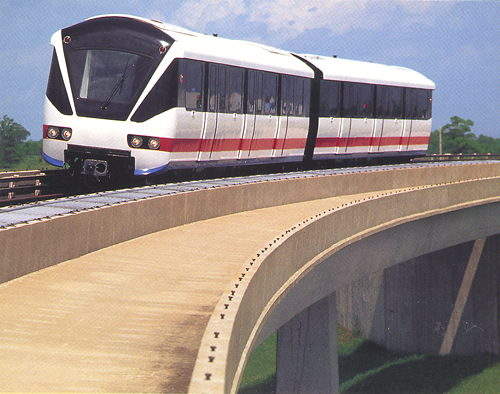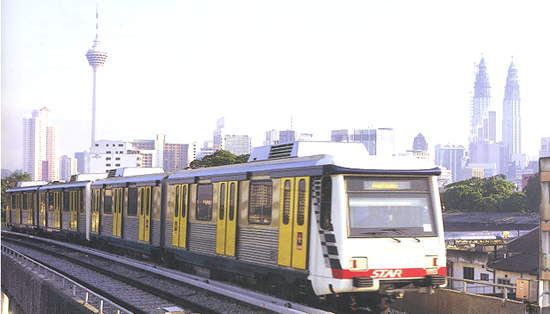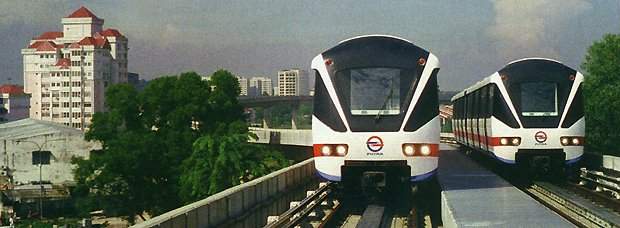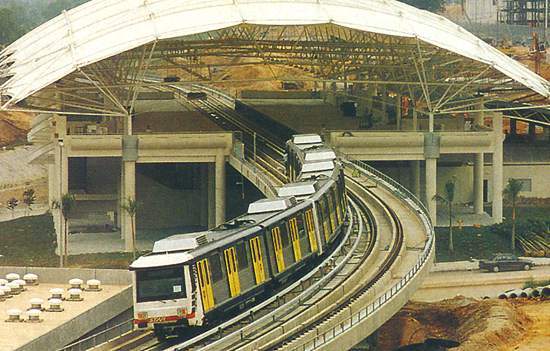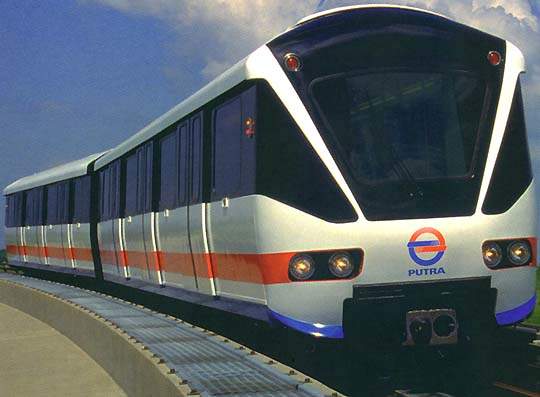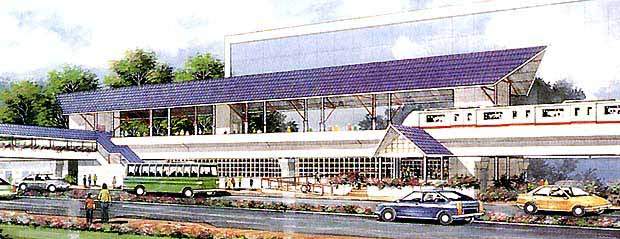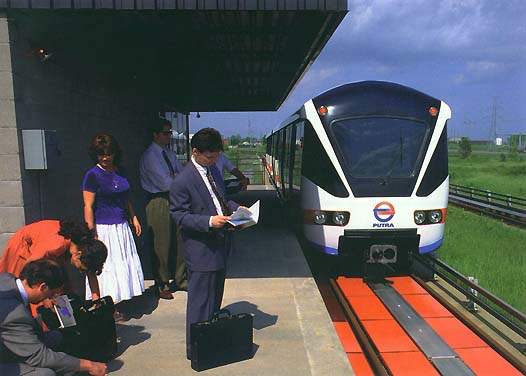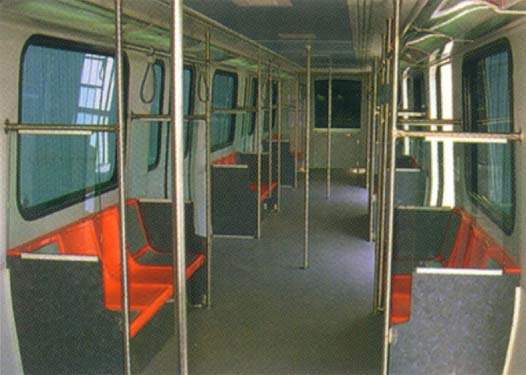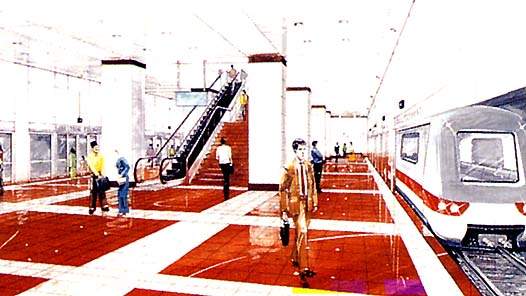Light Rail came to Kuala Lumpur in 1998 with the creation of the first section of an automatic mass transit system, running from east to west across one of the fastest growing cities in the world.
It has suffered from severe financial difficulties, however, and in June 2001 was taken over by the Government. New management took over in September 2002, when the line was renamed Purtaline and became the responsibility of Syarikat Prasarana Negara Berhad under the first phase of a mass restructuring of the city’s entire public transport networks.
Two years later, the system’s operation was transferred again to Rapid KL, a Government-owned company, but ownership remained with Syarikat Prasarana Negara Berhad. The line’s name changed again in June 2005 to its present title, the Kelana Jaya Line.
The system is popular and well-used, as the city’s roads are hopelessly gridlocked. Linking the city’s People’s Park and Gombak, the fast, efficient east-west route services some of the most affluent and heavily populated areas and was completed during 1999.
The 29km-long system is the world’s second longest fully-automated driverless metro system and the longest self-powered metro in Asia.
The project
The system was developed by Projek Usahasama Transit Ringan Automatik (PUTRA), a wholly-owned subsidiary of Renong, a 100% Malaysian-owned company.
Following financial difficulties, the Malaysian Government arranged a Malaysian $5.5bn bonds issue to buy PUTRA’s assets, and also those of the associated two-line metro company Sistem Transit Aliran Ringan (STAR). The funds raised settled the debts and converted Government loans into equity.
Construction of the first 29km stretch of the LRT was divided into two parts: Section 1, from Subang Depot to Pasar Seni Station, commenced operation in September 1998 and Section 2, from Pasar Seni Station to Terminal PUTRA, started up in June 1999.
Seven years after the final section opened, an extension was commissioned in August 2006 as part of a massive scheme to expand Kuala Lumpur’s transport network. It will add further track to the western end of the route to enter the Bandar Sunway, Subang Jaya and UEP Subang Jaya suburbs.
Infrastructure
The Kelana Jaya Line, formerly the Purta LRT, has 24 stations along its length and was constructed in two sections: Lembah Subang to Pasar Seni, and Pasar Seni to Ampang Park and Gombak. The first phase is on elevated single-track bridge sections, which are also used for 8km (4.9 miles) of 14.9km (9.3 miles) of the second phase, avoiding conflict with existing roads. Some 4.3km (2.7 miles) runs through a tunnel.
The focal point of the system is People’s Park, in the west of Kuala Lumpur and journey times to each end of the route are 45 minutes to Gombak and 21 minutes to Pasar Seni. Five stations are underground, and four stations are designed for park-and-ride expansion.
The average train speed is 40km/h (25mph), with an ultimate capacity of 30,000 passengers per hour in each direction, three times the present figure. The system operates for 18 hours a day.
Safety is also stressed in the design of the stations, with all platform edges being protected by a barrier, with an intrusion detection system incorporated to prevent passengers getting too close to the moving trains or tracks.
Every platform has emergency buttons and two-way passenger assistance telephones linked to the central control room, which will also monitor fixed CCTV cameras located throughout the system.
To ease monitoring, stations are constructed to a standard design, each with the same 68m platform length. Through the use of permanent rail fixings, rather than ballasting, a 5cm gap is achieved between the trains and the platform edge, allowing easy access for disabled travellers.
Gradients along the network are slight, with a maximum of 5%. This enables an initial average speed of 38km/h (23.6mph).
Links with other transport systems are an important part of the network. Each station has dedicated feeder bus stops, and interchanges with existing rail lines at Brickfields (KTM line), Jalan Tun Perak (STAR line), and to the route from the city centre to Kuala Lumpur Airport.
Rolling stock
The system started out with a fleet of 70 air-conditioned, aluminium-bodied vehicles powered by two linear induction electric motors, which keep noise levels to a minimum.
They were built by Bombardier and operate as 35 two-car sets, each accommodating 64 seated passengers and up to 350 standing at peak times. The trains are heavily based on those in service with Vancouver SkyTrain, and system operator BC Transit worked with Bombardier to supply electrical and mechanical equipment.
Power is provided through 14 sub-stations with 750V DC supplied to a live third rail. All cars are driverless, and they are fitted with a steerable suspension to improve ride quality.
The system is running at maximum capacity, and October 2006 saw a new $210m order, initially for 88 additional advanced rapid transit (ART) Mk II cars, placed with Bombardier and local partner Hartasuma.
The agreement includes an option for 52 additional cars that are due to enter service in 2008-10, and will be formed into 22 four-car sets.
Signalling and communications
The network boasts fully automated signalling to provide a service level of 90 seconds during peak hours and between 5 and 10 minutes in the off-peak.
Two-way communications on board trains allow passengers to speak to the central control room at any time. Fare-collection is fully automatic, while the busiest stations are designed to a standard formula to include ramps and elevators, specially textured floor surfaces, pre-recorded station announcements, and reserved seats for the elderly and wheelchair-bound.
Information systems on board each vehicle allow each station on the system to be illuminated on a map display as the train approaches it.
Despite the high level of automation, the metro still offers substantial employment opportunities in Kuala Lumpur and its environs, with up to 160 operations and 220 maintenance staff employed.
The future
The Government takeover is allowing the city’s public transport to be restructured. Its troubles have since been resolved, and Kelana Jaya Line has a reasonable performance record.
The expansion of the rolling stock fleet and the proposal for an extension of the network will see the system grow in line with Kuala Lumpur’s population, and the aim is to attract many more travellers out of their cars.

